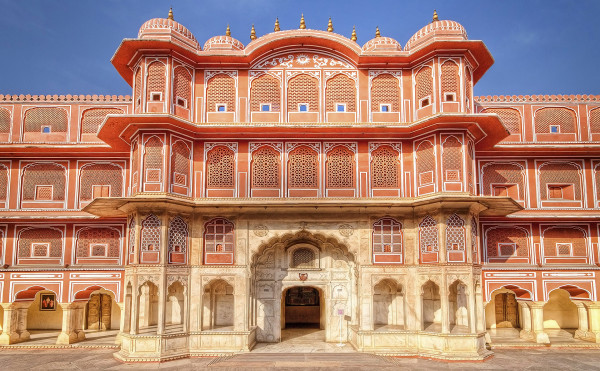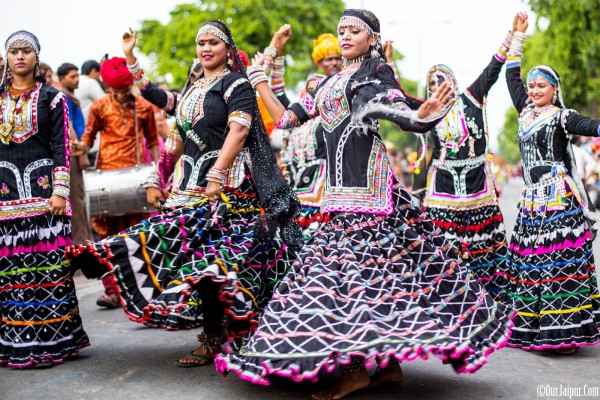Jaipur City – The Pink City of India
Jaipur Pink City History:
Jaipur city is one of the most attractive cities in India. It has a lot of thick culture and heritage. It is visited by many tourists every day and is famous as Pink City. During the rule of Swami Ram Singh, the city was painted pink to welcome Prince Edward VII and Queen Victoria. The pink attracts a lot, and many avenues remain painted pink. Since then, Jaipur city has been calling as Pink city. This city has many attractive palaces, three hill forts, Hawa Mahal, and many beautiful monuments. The town is famous for embroidery leather shoes, blue pottery, exotic wares, and tie-and-dye clothes. The Thar desert is very near the western side of Jaipur city. So the desert influenced the lifestyle of the people and their architecture.

Jaipur Pink City Construction:
Sawai Jai Singh II founded Jaipur city in 1727 AD. Vidyadhar Bhattacharya, the renowned Shilpa Charya in those days, planned the city’s layout. It has been laid according to the principles of ancient architecture books. The construction followed the nine-grid pattern, which beliefs lucky by the Indians. Among the nine-grid design, each grid consists of a square and the city palace stand in the heart of the grid. Around the centre palace, we can see the public buildings, noblemen’s residences and merchants’ houses.
Later it turned into the capital of Rajasthan. In the city, the broad avenues contain spacious gardens. Jaipur’s history has a strong culture and tradition. When we look at the palaces, magnificent forts, and the blushed pink mahals where we once lived mah, Barajas makes us feel the past comes alive. The widespread bustling streets of Jaipur are famous for Rajasthani jewellery, fabric and shoes, which have a timeless quality, and the same shops seem like a treasure trove to the tourists.
Jaipur city and beauty:
The straight and wide roads run through Pink city. A wall around the town had seven gateways g ae entry points. Now it isn’t easy to locate the wall because the city has grown far beyond the old city ramparts. But observed keenly, we could find the proof of the boundary wall. The town never faced the sieges of any other rulers. Jaipur city’s architectural planning belongs to ancient times, but every construction shows a modern appearance. The palace complex and other famous buildings and architectural plans combine Rajput and Mughal styles.
The darbar court was constructed by following Mughal tradition. The court area seems more open and is characterised by arched pavilions on delicately crafted pillars. Slender ornamental work gave the construction a good look. The public also extends their locations with great sculpture works, making the city more beautiful. Every house in Jaipur had ornamental windows to look the ceremonies through the streets. Gardens added to external vistas, water, canals, and fountains bring a different look. These decorations are quite similar to the Mughal palace and the gardens.

Jaipur City Attractions
Jaipur attracts visitors in large amounts. The celebrations of the pageants, festivals and the wearing clad of the people seem extraordinary, the wealth of handicrafts, the palaces, sightseeing and much more make the tourists put full attention on all these. The city is an architectural gem; once the visitors walk around the old town, no doubt they can forget their schedule. Every piece of artwork on the palaces makes the visitors immerse in joy.
Places to visit in Jaipur
The Olympian palace, Jantar Mantar and Janana Mahals. Lord Krishna, the blue-hued God temple, was constructed in 1719. City Palace, Hawa Mahal, Amer Fort, Nahargarh Fort, sargasso, Govind Devji Temple, Niwas Bagh, Vidyadharji Ka Bagh, Sisodia Rani Ka Bagh, Jaigarh Fort, Moti Doongri and Jal Mahal.
Spoken Languages in Jaipur City
In Rajasthan, people commonly speak English and Hindi. In the hotels and restaurants, the staff speaks English and Hindi. The tourists can easily communicate anywhere in Jaipur with a minimum knowledge of Hindi and English.
Dress of the People:
Men wear trousers and shirts. Women wear the traditional taste dresses like saree and salwar kameez. People mostly wear Loose cloth during the day due to heavy humidity.
Buying Liquor:
Liquor outlets are available everywhere around the city. Private owners have run them. All hotels, restaurants and pubs serve the liquor. The government ban Liquor sales on National Holidays.
Moving Around Transport:
The transport facilities are well advanced. For transport, there are buses, tempos and minibuses available. There are also auto rickshaws and taxis. There are tourist taxis at all the gates on M.I.Road. The travelling and hotel agents arrange for taxis on the demand of the tourists.
How to reach Jaipur:
Air: Jaipur airport is connected to all major cities in India.
Rail: Jaipur railway station had connectivity with Delhi, Agra,
Ahmedabad, Ajmer, Udaipur and Mount Abu.
Road: Jaipur connects with Delhi 258 km, Agra 236 km, Bikaner 321 km, and Udaipur 405 km. Ajmer 131 km, Jodhpur 316 km, Bharatpur 176 km, Jaisalmer 638 km and Bombay 1202 km. Bus connectivity is very flexible in these cities.
One thought on “Jaipur City – The Pink City of India”